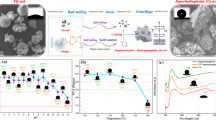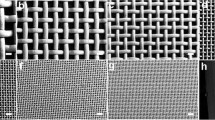Abstract
A simple and effective superhydrophobic mesh was designed and made to separate oil-water mixture. Alkali-activated fly ash reacted with 1-bromooctadecane to prepare superhydrophobic modified fly ash (MFA) with low surface energy through Williamson ether synthesis. The MFA powder was then coated uniformly on a stainless steel mesh (SSM) along with the epoxy resin E44 and curing agent T31 to give the superhydrophobic MFA-modified stainless steel mesh (MFA-SSM). The MFA-SSM has a high static water contact angle (CA) of 150.1° and can separate various oil or organic solvent from water with >95% separation efficiency. The oil-water separation efficiency remained high after 30 runs of petroleum ether/water separation. The developed superhydrophobic stainless steel mesh is expected to have wider use in oil-water separation.
Similar content being viewed by others
References
Ruebrg E J, Williams T D, Elliott J E. Review of Petroleum Toxicity in Marine Reptiles[J]. Ecotoxicology, 2021, 30(4): 525–536
Meo S A, Al-Drees A M, Rasheed S, et al. Effect of Duration of Exposure to Polluted Air Environment on Lung Function in Subjects Exposed to Crude Oil Spill into Sea Water[J]. Int. J. Occup. Med. Env., 2009, 22(1): 35–41
Meo S A, Al-Drees A M, Meo M M U, et al. Lung Function in Subjects Exposed to Crude Oil Spill into Sea Water[J]. Mar. Pollut. Bull., 2008, 56(1): 88–94
Magalhaes K M, Carreira R S, Rosa J S, et al. Polycyclic Aromatic Hydrocarbons (PAHs) in Fishery Resources Affected by the 2019 Oil Spill in Brazil: Short-term Environmental Health and Seafood Safety[J]. Mar. Pollut. Bull., 2022, 175: 113 334
Deng Y Y, Peng C S, Dai M, et al. Recent Development of Super-wettable Materials and Their Applications in Oil-water Separation[J]. J. Clean. Prod., 2020, 266: 121 624
Yu L, Han M, He F. A Review of Treating Oily Wastewater[J]. Arab. J. Chem., 2017, 10: S1 913–S1 922
Ejeta D D, Wang C F, Kuo S W, et al. Preparation of Superhydrophobic and Superoleophilic Cotton-based Material for Extremely High Flux Water-in-oil Emulsion Separation[J]. Chem. Eng. J., 2020, 402: 126 289
Qu M N, Ma X R, He J M, et al. Facile Selective and Diverse Fabrication of Superhydrophobic, Superoleophobic-Superhydrophilic and Superamphiphobic Materials from Kaolin[J]. Acs Appl. Mater. Inter., 2017, 9(1): 1 011–1 020
Gu J C, Xiao P, Chen P, et al. Functionalization of Biodegradable PLA Nonwoven Fabric as Superoleophilic and Superhydrophobic Material for Efficient Oil Absorption and Oil/Water Separation[J]. Acs Appl. Mater. Inter., 2017, 9(7): 5 968–5 973
Cao M, Luo X M, Ren H J, et al. Hot Water-repellent and Mechanically Durable Superhydrophobic Mesh for Oil/Water Separation[J]. J. Colloid. Interf. Sci., 2018, 512: 567–574
Wu J, Li X, Wu Y, et al. Rinse-resistant Superhydrophobic Block Copolymer Fabrics by Electrospinning, Electrospraying and Thermally-induced Self-assembly[J]. Appl. Surf. Sci., 2017, 422: 769–777
Zhang M, Wu Z, Meng F, et al. Facile Preparation of Grass-like Hierarchical Structured γ-AlOOH Coated Stainless Steel Mesh with Superhydrophobic and Superoleophilic for Highly Efficient Oil-water Separation[J]. Separation and Purification Technology, 2019, 212: 347–352
Wang C Y, Shao Y, Zhang K F, et al. Facile Approach to Fabricate a High-Performance Superhydrophobic Mesh[J]. Acs Appl. Mater. Inter., 2021, 13(13): 15 720–15 726
Li Z, Qian W, Chen Y, et al. A New Treasure in Industrial Solid Waste—Coal Fly Ash for Effective Oil/water Separation[J]. Journal of the Taiwan Institute of Chemical Engineers, 2021, 118: 196–203
Hashemi A, Bahari A. Structural and Dielectric Characteristic of Povidone–silica Nanocomposite Films on the Si(n) Substrate[J]. Applied Physics A, 2017, A(123): 535
Coyopol A, Garcia-Salgado G, Diaz-Becerril T, et al. Strong White Light Emissi on from SiCxOy Films Grown by HFCVD Technique[J]. Opt. Mater., 2020, 99: 109 551
Li H Y, Wang R G, Hu H L, et al. Surface Modification of Self-healing Poly(urea-formaldehyde) Microcapsules Using Silane-coupling Agent[J]. Appl. Surf. Sci., 2008, 255(5): 1894–1900
Chen S, Hayakawa S, Shirosaki Y, et al. Sol-Gel Synthesis and Microstructure Analysis of Amino-Modified Hybrid Silica Nanoparticles from Aminopro- pyltriethoxysilane and Tetraethoxysilane[J]. Journal of the American Ceramic Society, 2009, 92(9): 2 074–2 082
Pantoja M, Velasco F, Broekema D, et al. The Influence of pH on the Hydrolysis Process of y-Methacryloxypropyltrimethoxysilane, Analyzed by FT-IR, and the Silanization of Electrogalvanized Steel[J]. Journal of Adhesion Science and Technology, 2010, 24: 1 131–1 143
Nishitoba T, Yoshida N, Kondo J N, et al. Control of Al Distribution in the CHA-Type Aluminosilicate Zeolites and Its Impact on the Hydrothermal Stability and Catalytic Properties[J]. Industrial & Engineering Chemistry Research, 2018, 57(11): 3 914–3 922
Li J, Li D M, Yang Y X, et al. A Prewetting Induced Underwater Superoleophobic or Underoil (super) Hydrophobic Waste Potato Residue-coated Mesh for Selective Efficient Oil/water Separation[J]. Green Chem., 2016, 18: 541–549
Guo Z Y, Zheng X, Tian D L, et al. Photoelectric Cooperative Patterning of Liquid Permeation on the Micro/nano Hierarchically Structured Mesh Film with Low Adhesion[J]. Nanoscale, 2014, 6: 12 822–12 827
Author information
Authors and Affiliations
Corresponding author
Additional information
Conflict of interest
WFZ is an editorial board member for this journal and was not involved in the editorial review or the decision to publish this article. All authors declare that there are no competing interests.
Funded by Hubei Technology Innovation Key Program (No. 2018AAA004)
Rights and permissions
About this article
Cite this article
Yu, Y., Liu, P., Wang, F. et al. Preparation of Hydrophobic Fly Ash by Surface Modification and Oil-water Separation Devices. J. Wuhan Univ. Technol.-Mat. Sci. Edit. 38, 695–700 (2023). https://doi.org/10.1007/s11595-023-2748-7
Received:
Accepted:
Published:
Issue Date:
DOI: https://doi.org/10.1007/s11595-023-2748-7




